COVID-19 and CFD simulation for planes, trains and automobiles (and more)
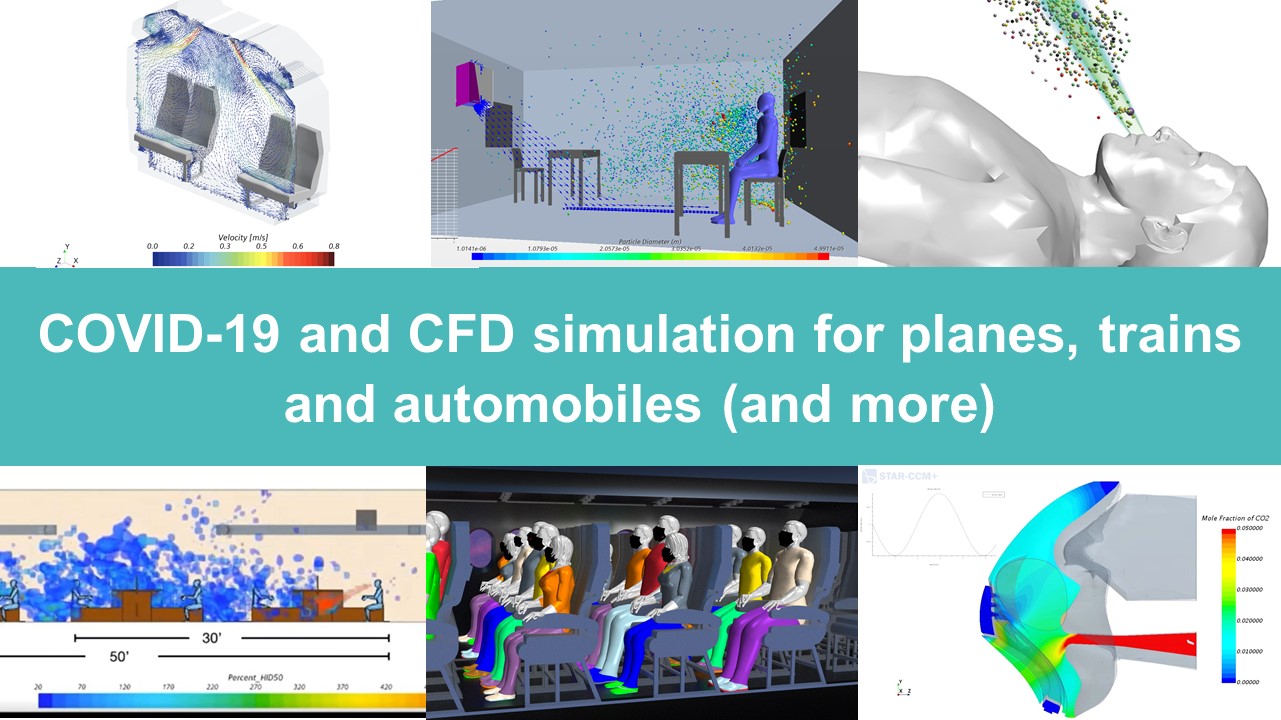
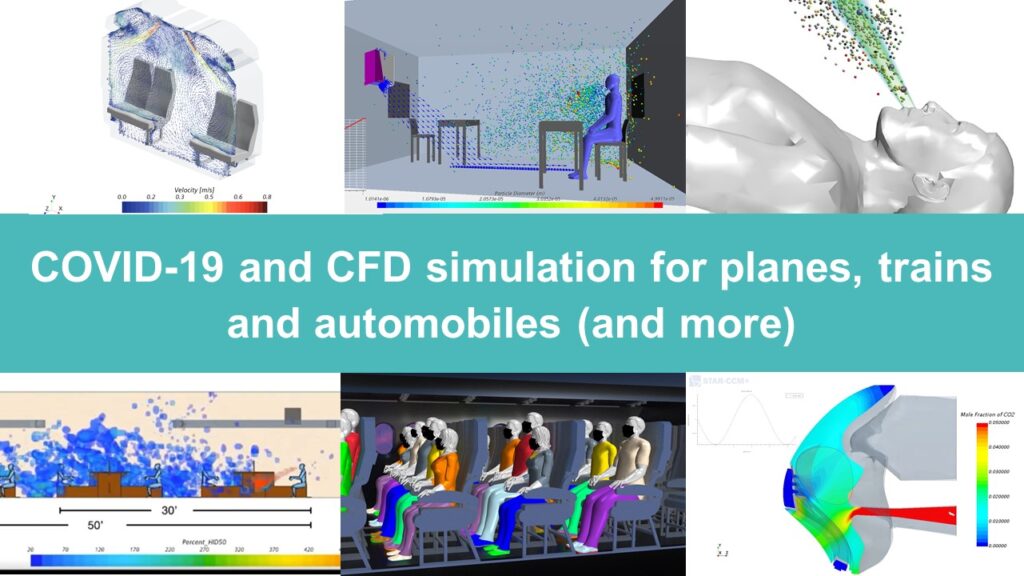
The coronavirus (COVID-19) pandemic has spurred the global community into action unlike any other time in recent history. Governments continue to fight the deadly virus with public health measures. Healthcare workers are on the frontlines saving lives. The medical & scientific community are working on decoding the virus propagation, infection and developing vaccination.
As a technology leader, Siemens is no different –
- Delivering COVID-19 test kits.
- Enabling sterilizing & disinfection robots.
- Developing ventilation devices.
- Providing antibody testing.
The response from Siemens Digital Industries Software and Siemens Healthineers has been swift. More importantly, our customers are using digitalization and automation against the virus where they can.
In this fight, computer simulations based on computational fluid dynamics (CFD) technology can be a crucial asset. CFD simulation software from Siemens’ Simcenter portfolio are currently being used by industry and academia in various COVID-19 related applications.
(For the uninitiated, CFD simulation involves solving fluid flow, heat transfer and other multiphysics with numerical methods. Companies use CFD to predict the performance of everything from planes, cars, ships, chemical processes, biomedical devices, etc.)
Below are some real-life applications of COVID-19 CFD simulations from our customers in the fight against COVID-19.
Click on the titles for the full story:
JB&B – CFD simulations show opening windows is key to reopening schools
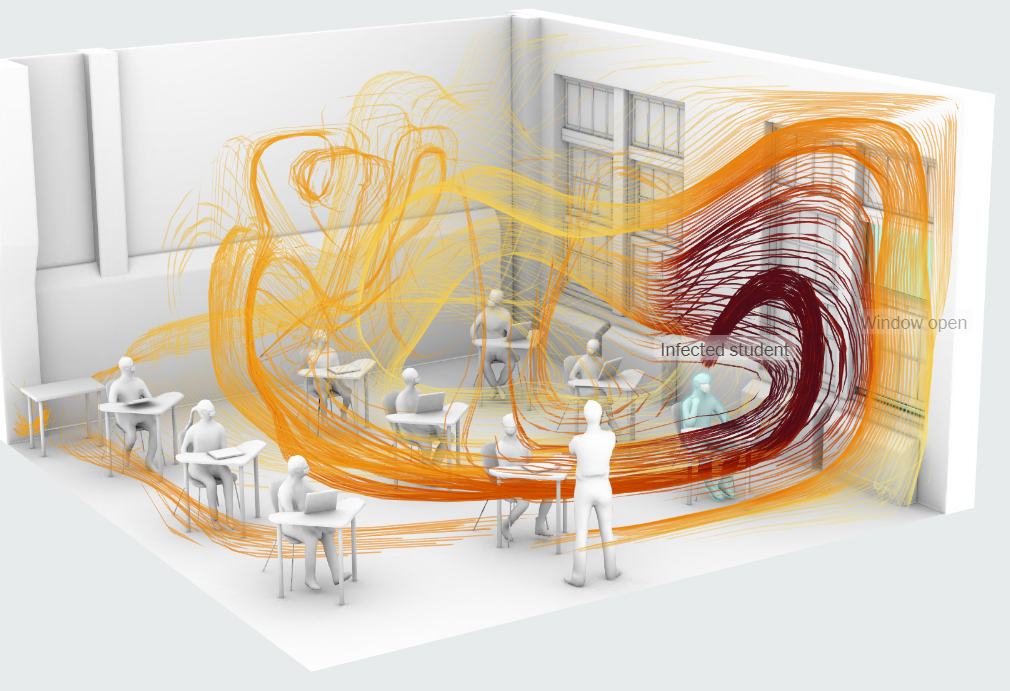
Jaros, Baum & Bolles (JB&B), an engineering consulting firm, worked closely with the New York Times to show how schools can reduce COVID-19 exposure in classrooms by opening windows.
The engineers at JB&B used Simcenter Flovent CFD simulations to show how contaminants from an infected student circulate in a classroom for three scenarios – windows closed, windows open and with a fan and air cleaner installed.
The story in New York Times is a must-read and is a brilliant visual representation of how to keep infected contaminants to a minimum in a classroom setting.

Click on the QR code above for an augmented reality experience that puts you inside an airflow simulation. See how ventilation changes how contaminants can spread indoors.
To experience this in your space, you will need the Instagram app. To view on Instagram, open the camera on your device and point to the QR tag below.
Heraeus Noblelight – Developing first UVC air purifier for buses with CFD simulation
Heraeus Noblelight, together with the Hygiene Institute Biotec GmbH, has developed a novel ultraviolet-C (UVC) air purifier that eliminates 99.999% of the surrogate viruses. Ultraviolet light at specific wavelengths can reliably destroy the genetic material of the virus.
The design team utilized CFD simulations in Simcenter STAR-CCM+ to simulate the aerosol transport and concentration decrease running a UVC disinfection device. The simulation results were confirmed in physical tests as well.
The CAE innovation team, led by Dr. Larisa von Riewel, have used Simcenter STAR-CCM+ simulation, to bring this innovative device to life.
With this, Heraeus Noblelight has delivered the first air purifying solution for buses worldwide killing 99.9% of the viruses in air in a few minutes. The UVC device has already been tested on real city buses in Hanau, Germany. The video below from Heraeus’ Youtube page shows the first UVC purifiers deployed in the city buses.
Airbus – Understanding cough droplet propagation in aircraft cabin
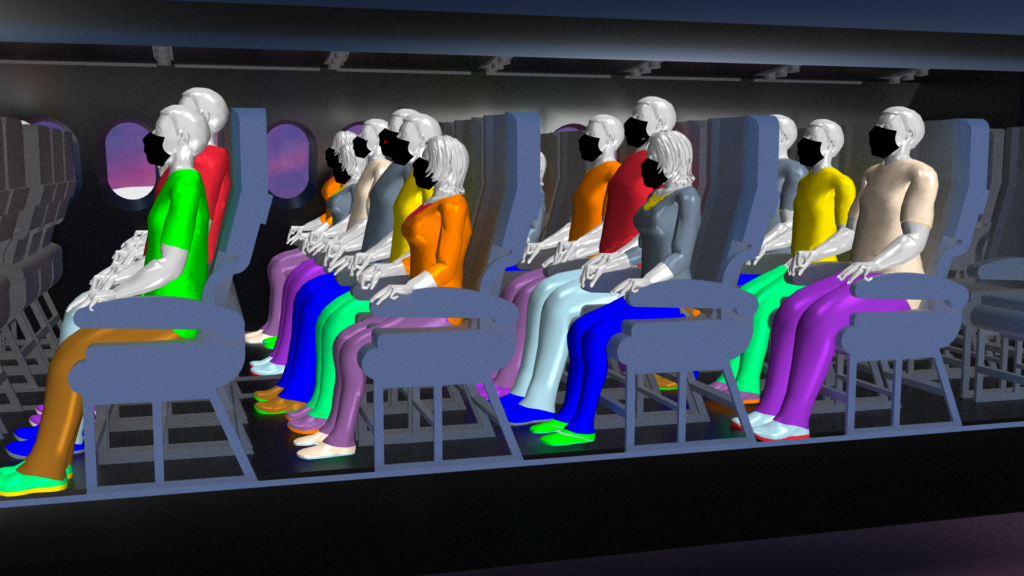
Siemens and Airbus are using Simcenter STAR-CCM+ to understand the transport of particles/droplets from a human cough in an aircraft cabin.
Using CFD simulations, the team has modeled the transport of cough droplets in an aircraft cabin. The impact and effectiveness of face masks in reducing droplet transmission in an aircraft is modeled too.
The joint team developed the CFD methodology that tackles three things:
- Simulation of cough droplets from an average human
- Challenges in modeling aircraft cabin environment
- Steps involved in understanding risk of virus transmission from cough droplets
You can watch the webinar by clicking the link below.
UES/USAF – Evaluating biological agent transport in aircraft
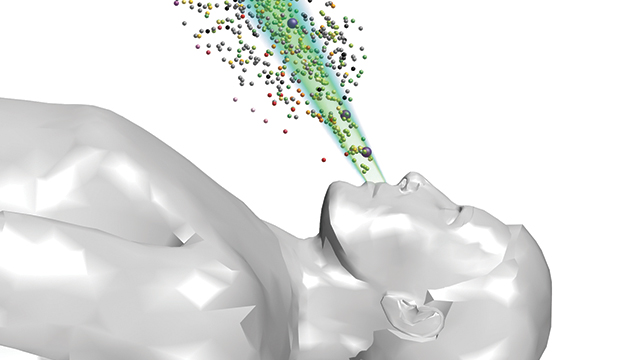
How do you identify bioaerosol contamination hot spots in an aircraft and confirm decontamination after exposure?
UES, Inc. partnered with the US Air Force Research Laboratory’s 711th Human Performance Wing (HPW) to find the answer using Simcenter STAR-CCM+. Simcenter Engineering Services helped the team to simulate a cough from an infected passenger in a C-130 Hercules aircraft with multiple passengers.
The results from the CFD simulations will be used in guiding improved procedures and sampling strategies for bioaerosol detection and surface decontamination. This helps the US Air Force make critical decisions regarding transport of infectious patients.
HOLT Architects/ME Engineering – Creating safer office spaces during COVID-19 with CFD
One area where CFD simulations can be of great use is smaller indoor spaces where the airflow and ventilation can be controlled better.
HOLT Architects, in association with M/E Engineering, recently published some interesting results on their strategies for reducing airborne transmission. M/E Engineering are well known for their expertise in CFD modeling. Using Simcenter STAR-CCM+, they have helped HOLT architects study droplet transmission in their Ithaca, NY office. This study and the redesign of the ventilation system is helping employees return safely to the office.
CAD models of the actual office space were used. CFD simulations of multiple coughs with and without a face mask were analyzed with Simcenter STAR-CCM+. The analysis considered office arrangement, furniture, air flow patterns, barriers and location of people.
I highly recommend watching the comparison at 1:10 seconds. It shows spread of cough droplets with and without a mask in their office.
This kind of environment-specific cough simulation can help redesign HVAC and indoor ventilation systems. The smaller the space (and indoors), the lesser the variables that control droplet transmission. This increases the value of CFD simulations to run multiple what-if scenarios to understand COVID-19 transmission.
What if an infected patient coughs? What if the HVAC system is changed? What if a window could be open? Where to face sterilization/disinfection devices? Just some of the questions that CFD can answer here.
Norton Straw – Novel air sterilization device and transmission in trains
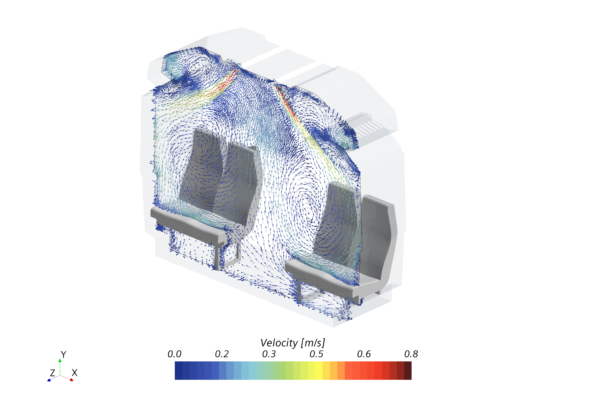
Norton Straw, the UK based engineering and management consulting firm has been busy helping companies adapt to the new normal with simulation.
For the transportation industry (planes, trains and automobiles….ships too), COVID-19 has brought the indoor spaces into greater focus. A UK Rolling Stock Owning Company (Trains, for readers from the rest of the world) contacted Norton Straw to help minimize transmission on-board the trains.
Using CFD simulation with Simcenter STAR-CCM+, the engineers at Norton Straw analyzed the airflow in the train cabin resulting from many mitigation strategies – windows open, plastic shield between passengers, different ventilation air flow, etc.
The simulation results, also presented with Simcenter STAR-CCM+ Virtual Reality (VR), helped the manufacturer assess the ventilation effectiveness of different cabin configurations
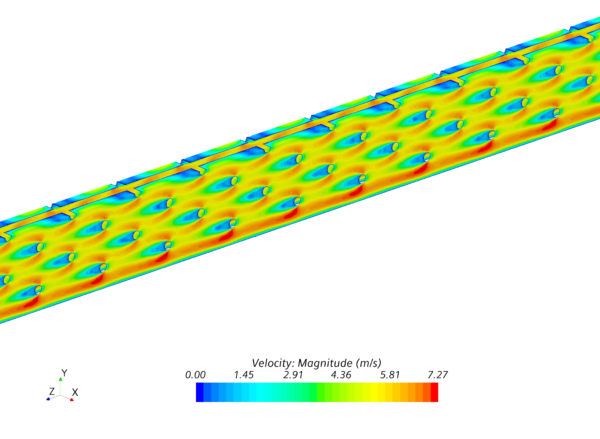
In another application, Norton Straw used Simcenter STAR-CCM+ to develop a novel concept of air sterilization device.
Why is this novel? Because the device is designed to protect individuals in work environments where social distancing is impossible. Using CFD simulations and design optimization, the company has designed a small, light and energy efficient sterilization device. The device won the Innovate UK Covid Response Grant.
The easily manufacturable device is currently being produced with additive manufacturing. Treating the recirculated air in indoor environments with such an air sterilization device is a solution for rail, automotive and building applications.
Vyaire – Designing respiratory devices for COVID-19 treatment with CFD

Ventilators (and respiratory support devices in general) have emerged as the emblematic devices of the fight against COVID-19. Vyaire Medical, one of the world’s largest producers of respiratory care equipment, have been using simulation to ensure that their respiratory care devices work equally well for people of all shapes and sizes and from all demographic backgrounds, as described in detail in a recent blog post.
Texas A&M – Investigation of a human sneeze
A special mention goes out to the researchers at Texas A&M University. They have published results from their investigation into a human sneeze. Essentially, the research studies how long and how far the sneeze droplets go. This is critical in understanding and evaluating transmission of droplets in indoor spaces – the main source of COVID-19 transmission.
The research team studied real human sneezes (ewww!) to develop inputs for the digital models. The coolest part here is the comparison between the real sneeze and it’s digital counterpart.
Modeling a sneeze accurately is incredibly hard, something the team at Texas A&M has done really well. An accurate digital sneeze is the first step in investigating droplet spread in indoor spaces via simulation.
Where can CFD simulations actually help against COVID-19?
The above examples show how Siemens’ customers have used CFD simulations in the fight against COVID-19.
It goes without saying that CFD simulations cannot (and should not) be used as public health guidelines. That’s best left to virologists and epidemiologists.
But CFD simulations, if applied right, can help in three areas:
- Understanding transport of human exhalations, concentration and mitigation
- CFD simulation offers multiple approaches to model droplets and aerosols and their transport in space and time. By modeling exhalation of droplets/aerosols from talking, coughing and sneezing, CFD simulations can show where these particles travel to, how long they stay in air and what surfaces they impinge on.
- This would generally be useful in a small indoor setting with some sort of controlled airflow (rooms, cars, trains, planes, etc). Outdoors, the number of variables increases and forming any conclusive
- The best reason to use CFD simulation is the ability to track and investigate every single droplet from a human exhalation.
- Improving/Redesigning indoor environments for safety
- CFD simulations have long been used to understand indoor air flows and design HVAC systems and indoor environments for comfort and safety.
- CFD combined with design optimization can help analyze hundreds of ‘what-if’ scenarios for indoor environments.
- For example, you can analyze multiple venting configurations and air curtains to ensure most of the droplets and aerosols in a room are removed.
- Air purifiers and disinfectants can be designed to focus on areas of high droplet concentration.
- Designing equipment in the fight against COVID-19
- CFD simulations are used in the design of ventilators and other respiratory equipment for treatment. In addition, biomedical companies also use CFD simulations to aid vaccine production.
- A post-Covid world will see indoor environments come into greater focus. How do you sterilize and purify indoor spaces? Here, CFD simulations can help in designing purifying equipment.
We now understand the virus better. Masking and social distancing is reducing transmission. But more importantly, the first vaccines are already here. Hopefully, the ‘new normal’ will soon go back to just ‘normal’.
As a software vendor, it gives us great pride to see our customers apply Simcenter CFD simulations and digital twins to fight a global pandemic.
For long, the tagline for Siemens read ‘Ingenuity for life‘. Today, we appreciate and applaud our customers who are showing ‘Ingenuity for life’ in action.
Stay safe and stay healthy, everyone!



Comments
Comments are closed.